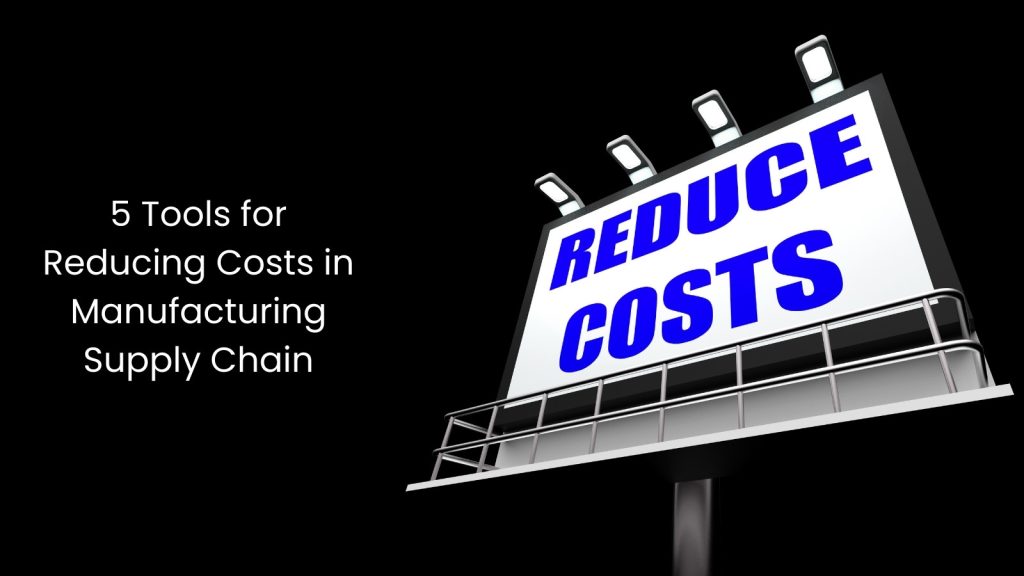Did you know that nearly 60% of manufacturing companies struggle with high supply chain costs? In this modern and competitive market, optimising the supply chain is the key factor to staying profitable. Many businesses face challenges in managing raw material costs, transportation expenses, and inventory management inefficiencies. However, by adopting the right strategies, manufacturers can significantly reduce these overheads. One such approach is utilising technology to automate and streamline operations, cutting down on time and reducing human error.
In this article, we look into the top five tools that can help manufacturers reduce supply chain costs strategically.
In this article, we look into the top five tools that can help manufacturers reduce supply chain costs strategically.
Understanding the Supply Chain in the Manufacturing Industry

- The manufacturing supply chain starts when a company gets raw materials and ends when the final product reaches the customer. Every step, like sourcing parts, planning production, managing suppliers, and shipping goods, plays a big part in keeping things moving.
- In this system, companies do not work alone; they depend on others, such as vendors, transport partners, and distributors. To keep costs low and avoid delays, manufacturers need to track inventory in real time, improve production processes, and respond quickly to market demand.
- These days, many businesses use tools like ERP software, real-time tracking, and automation to boost supply chain efficiency and avoid waste. They also use demand forecasting and strong logistics strategies to reduce extra stock and speed up delivery.
- So, smooth coordination between different departments, including procurement, manufacturing operations, and logistics, helps things run better.
5 Tools for Reducing Costs in Manufacturing Supply Chain

Manufacturing Execution Systems (MES)
MES helps factories save money and improve the manufacturing supply chain by tracking everything that happens on the shop floor in real time.
When workers use MES, they can see which machines run smoothly and which ones slow things down, so they fix problems faster and avoid wasting time or materials. These systems also make sure employees follow the right steps during production, which cuts down on mistakes and lowers the cost of rework or rejected products.
Instead of guessing, managers use real data from MES to make smarter decisions about production planning, inventory control, and labour use.
Further, MES connects with other systems like ERP and supply chain management software to share updates instantly, so supply chain teams stay in sync and avoid delays. When orders change or demand spikes, MES helps factories adjust quickly without causing chaos.
Plus, the system watches material use and warns when supplies run low, which keeps production from stopping and reduces the risk of overstock.
When workers use MES, they can see which machines run smoothly and which ones slow things down, so they fix problems faster and avoid wasting time or materials. These systems also make sure employees follow the right steps during production, which cuts down on mistakes and lowers the cost of rework or rejected products.
Instead of guessing, managers use real data from MES to make smarter decisions about production planning, inventory control, and labour use.
Further, MES connects with other systems like ERP and supply chain management software to share updates instantly, so supply chain teams stay in sync and avoid delays. When orders change or demand spikes, MES helps factories adjust quickly without causing chaos.
Plus, the system watches material use and warns when supplies run low, which keeps production from stopping and reduces the risk of overstock.
Warehouse Management Systems (WMS)
The latter helps companies cut costs and work smarter by keeping full control over how they store, move, and track products inside a warehouse.
When manufacturers use WMS, they do not waste time searching for items or making guesswork decisions because the system tells them exactly where everything sits and when it moves. Workers pick and pack items faster, which means orders leave the warehouse on time and with fewer mistakes. That saves money on returns and unhappy customers.
The system also tracks how much stock a company has in real time, so they avoid overordering or running out of supplies. Instead of letting goods collect dust, WMS helps teams rotate inventory better, especially items that expire or move slowly.
As more companies look to cut extra costs and stay competitive, WMS gives them the control and speed they need to keep their warehouses running like clockwork.
When manufacturers use WMS, they do not waste time searching for items or making guesswork decisions because the system tells them exactly where everything sits and when it moves. Workers pick and pack items faster, which means orders leave the warehouse on time and with fewer mistakes. That saves money on returns and unhappy customers.
The system also tracks how much stock a company has in real time, so they avoid overordering or running out of supplies. Instead of letting goods collect dust, WMS helps teams rotate inventory better, especially items that expire or move slowly.
As more companies look to cut extra costs and stay competitive, WMS gives them the control and speed they need to keep their warehouses running like clockwork.
Predictive Analytics Tools
It saves money and avoids surprises by using past data to guess what might happen next.
These tools study patterns in things like customer demand, supply deliveries, equipment health, and production speed. When managers see a possible problem ahead, like a late shipment or a machine that is likely to break, they fix it before it causes delays or extra costs.
This kind of thinking helps them plan smarter and stop wasting time or money on last-minute fixes. Instead of waiting for something to go wrong, they take action early.
For example, if the tool shows that demand for a product usually drops in certain months, the company can order fewer materials and avoid stock sitting on shelves too long. If the system warns about a machine slowing down, the team can schedule maintenance before it breaks and stops production.
These tools also help companies predict lead times, adjust delivery routes, and balance inventory levels, which keeps the entire manufacturing supply chain moving smoothly.
These tools study patterns in things like customer demand, supply deliveries, equipment health, and production speed. When managers see a possible problem ahead, like a late shipment or a machine that is likely to break, they fix it before it causes delays or extra costs.
This kind of thinking helps them plan smarter and stop wasting time or money on last-minute fixes. Instead of waiting for something to go wrong, they take action early.
For example, if the tool shows that demand for a product usually drops in certain months, the company can order fewer materials and avoid stock sitting on shelves too long. If the system warns about a machine slowing down, the team can schedule maintenance before it breaks and stops production.
These tools also help companies predict lead times, adjust delivery routes, and balance inventory levels, which keeps the entire manufacturing supply chain moving smoothly.
Digital Twin Technology
This digital version lets teams test ideas, spot issues, and fix problems before they affect actual production. When managers use a digital twin, they can watch how machines behave, how materials move, and how fast orders get done, all without touching anything on the factory floor.
They run what-if scenarios to see what happens if demand jumps, a machine breaks, or a supplier runs late. This kind of testing saves money because it stops guesswork and avoids mistakes that cost time or waste resources.
The team sees what works best, then uses that plan in the real world. As operations change, the digital twin updates in real time, which helps everyone stay on track and adjust fast. It also supports better maintenance planning because it tracks machine performance closely and helps the team fix small issues before they become big repairs.
When companies connect digital twins with other manufacturing supply chain tools like ERP or MES, they get a full picture of their system from start to finish. This clear view helps them plan smarter, reduce delays, and avoid stocking too much inventory.
They run what-if scenarios to see what happens if demand jumps, a machine breaks, or a supplier runs late. This kind of testing saves money because it stops guesswork and avoids mistakes that cost time or waste resources.
The team sees what works best, then uses that plan in the real world. As operations change, the digital twin updates in real time, which helps everyone stay on track and adjust fast. It also supports better maintenance planning because it tracks machine performance closely and helps the team fix small issues before they become big repairs.
When companies connect digital twins with other manufacturing supply chain tools like ERP or MES, they get a full picture of their system from start to finish. This clear view helps them plan smarter, reduce delays, and avoid stocking too much inventory.
Robotic Process Automation (RPA)
These software robots handle things like entering order details, checking inventory levels, sending shipping updates, and even creating invoices without making mistakes or needing breaks.
When manufacturers use RPA, they free up workers to focus on more important jobs that require thinking and decision-making. This shift cuts labour costs, speeds up daily tasks, and lowers the chance of errors that cause delays or waste.
RPA also helps with faster order processing because it updates systems instantly, which keeps customers happy and avoids shipping problems. When factories connect RPA with other supply chain tools like ERP or warehouse systems, everything works together more smoothly. For example, if stock runs low, the RPA bot can place a new order or send alerts before production slows down.
Moreover, the robots keep records updated in real time, which helps managers make smart choices without waiting for reports. Since RPA works around the clock, it handles big chunks of work overnight, which speeds things up even more. This kind of automation adds value across the entire manufacturing supply chain because it reduces the cost of doing business, boosts accuracy, and increases output without hiring more people.
When companies need to move faster and spend less, RPA steps in like a behind-the-scenes worker that never stops, never complains, and always follows instructions perfectly.
When manufacturers use RPA, they free up workers to focus on more important jobs that require thinking and decision-making. This shift cuts labour costs, speeds up daily tasks, and lowers the chance of errors that cause delays or waste.
RPA also helps with faster order processing because it updates systems instantly, which keeps customers happy and avoids shipping problems. When factories connect RPA with other supply chain tools like ERP or warehouse systems, everything works together more smoothly. For example, if stock runs low, the RPA bot can place a new order or send alerts before production slows down.
Moreover, the robots keep records updated in real time, which helps managers make smart choices without waiting for reports. Since RPA works around the clock, it handles big chunks of work overnight, which speeds things up even more. This kind of automation adds value across the entire manufacturing supply chain because it reduces the cost of doing business, boosts accuracy, and increases output without hiring more people.
When companies need to move faster and spend less, RPA steps in like a behind-the-scenes worker that never stops, never complains, and always follows instructions perfectly.
Cerexio Solutions for Reduced Manufacturing Supply Chain Costs

Cerexio provides advanced MES and WMS tools that help reduce errors, save time, and lower operational costs across the manufacturing supply chain. Our technology simplifies production tracking and warehouse management, making supply chains more efficient, responsive, and affordable without sacrificing quality or speed.
Staying Away from Unnecessary Costs in Your Manufacturing Supply Chain via Technology

You do not need to overspend to keep your supply chain strong. Modern tech gives manufacturers the tools to predict, prevent, and fix problems faster. With streamlined systems in place, you save time, money, and stress, making your manufacturing process leaner, quicker, and more reliable from start to finish.
